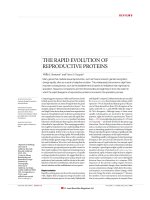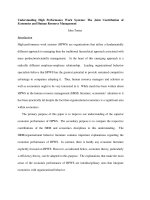Parental investment and the joint evolution of children’s cognitive and non-cognitive skills: evidences in Vietnam
Bạn đang xem bản rút gọn của tài liệu. Xem và tải ngay bản đầy đủ của tài liệu tại đây (4.22 MB, 101 trang )
UNIVERSITY OF ECONOMICS
HO CHI MINH CITY
VIETNAM
ERASMUS UNIVERSITY ROTTERDAM
INSTITUTE OF SOCIAL STUDIES
THE NETHERLANDS
VIETNAM - NETHERLANDS
PROGRAMME FOR M.A IN DEVELOPMENT ECONOMICS
PARENTAL INVESTMENT AND THE JOINT
EVOLUTION OF CHILDREN’S COGNITIVE
AND NON-COGNITIVE SKILLS:
EVIDENCES IN VIETNAM
BY
TRAN KHANH HOA
MASTER OF ARTS IN DEVELOPMENT ECONOMICS
HO CHI MINH CITY, December 2017
UNIVERSITY OF ECONOMICS
HO CHI MINH CITY
VIETNAM
INSTITUTE OF SOCIAL STUDIES
THE HAGUE
THE NETHERLANDS
VIETNAM - NETHERLANDS
PROGRAMME FOR M.A IN DEVELOPMENT ECONOMICS
PARENTAL INVESTMENT AND THE JOINT
EVOLUTION OF CHILDREN’S COGNITIVE
AND NON-COGNITIVE SKILLS:
EVIDENCES IN VIETNAM
A thesis submitted in partial fulfilment of the requirements for the degree of
MASTER OF ARTS IN DEVELOPMENT ECONOMICS
By
TRAN KHANH HOA
Academic Supervisor:
Dr. PHAM KHANH NAM
HO CHI MINH CITY, December 2017
DECLARATION
In order to fulfill the requirements for the degree of Master of Art in Development
Economics to Vietnam – The Netherlands Programme (VNP), this thesis entitled
“Parental investments and the joint evolution of children’s cognitive and noncognitive skills: Evidence in Vietnam” is submitted.
This declaration certify that this thesis constitutes on my original work only. All
materials used in this thesis have been acknowledged and cited properly following
the Programme’s standards
TRAN KHANH HOA
ACKNOWLEDGEMENTS
Academically, I would like to express my sincere gratitude to Dr. Pham Khanh Nam,
Dr. Truong Dang Thuy and Mr. Do Huu Luat for the valuable comments,
instructions and support, without which my thesis would have not been completed.
Personally, I would like to thank my big family, my loved one and friends for the
great care, understanding, encouragement, tolerance and patience during my tough
time of writing the thesis.
Tran Khanh Hoa
ABSTRACT
Given the importance of skill set as a predictor of life outcomes, this study
investigates the effect of parental investment on the development of cognitive and
non-cognitive skills of 2,000 children, who were tracked from age 1 to age 12, using
longitudinal data from Young Lives project in Vietnam. A model of skill formation
is estimated using ordinary least squares and full information maximum likelihood as
well as instrumental-variables to cope with missing values and potential endogeneity.
Cognitive and non-cognitive skills are latent variables obtained from confirmatory
factor analysis. There are three important findings in this study. Firstly, the results
support that parental investment plays a crucial role in the development of both
cognitive and non-cognitive skills in the first 12 years of child’s life. Secondly, there
is compelling evidence for the presence of self-productivity of cognitive-skills as well
as cross-productivity from cognitive skills to non-cognitive skills and vice versa.
Thirdly, the time span until the age of 12 is found to be critical period for the
development of cognitive skills while the age of 5 and the age of 8 are sensitive
periods for cognitive skills relative to the age of 12. These findings support policy
towards an education reform which help to promote not only cognitive skills but also
non-cognitive skills; and policy towards an early childhood intervention programs,
which aim at children living under disadvantage circumstances.
JEL Classification:
Keywords: parental investment, cognitive skill, non-cognitive skills, critical and
sensitive periods, children
i
TABLE OF CONTENTS
ABSTRACT ................................................................................................................i
ABBREVIATION ......................................................................................................iv
LIST OF FIGURES .....................................................................................................v
LIST OF TABLES .....................................................................................................vi
Chapter 1 INTRODUCTION ...................................................................................... 1
1.1.
Problem statement ...................................................................................... 1
1.2.
Research objectives ..................................................................................... 3
1.3.
Scope of the study ....................................................................................... 3
1.4.
Structure of the thesis ................................................................................. 4
Chapter 2 LITERATURE REVIEW ...........................................................................5
2.1.
Human capital theory: skills matter ......................................................... 5
2.2.
Cognitive skills and non-cognitive skills: measures and impacts ........... 6
2.3.
Determinants of skill development ............................................................ 8
2.3.1.
Genetic endowment .............................................................................. 8
2.3.2.
Environment ......................................................................................... 9
2.4.
Dynamics of skill development ................................................................ 11
2.4.1.
2.5.
Critical and sensitive periods: timing of parental investment ....... 12
Analytical framework ............................................................................... 13
Chapter 3 RESEARCH METHODOLOGY ............................................................. 15
3.1.
Methodology .............................................................................................. 15
3.1.1.
Technology of skill formation ........................................................... 15
3.1.2.
Genetic endowment – Initial conditions........................................... 17
3.1.3. Method in cognitive, non-cognitive skills measurement: Latent
variables ............................................................................................................ 18
3.1.4.
3.2.
Instrument Variables ......................................................................... 18
Data ............................................................................................................ 19
3.2.1.
Data source ......................................................................................... 19
3.2.2.
Variables description ......................................................................... 21
Chapter 4 RESEARCH RESULTS ...........................................................................25
4.1.
Overview .................................................................................................... 25
ii
4.2.
Descriptive statistics ..................................................................................28
4.2.1.
Summary statistics ..............................................................................28
4.2.2.
Bivariate analysis ................................................................................36
4.2.3.
Empirical results .................................................................................39
Chapter 5 CONCLUSIONS ...................................................................................... 57
5.1. Conclusion ....................................................................................................57
5.2. Policy implication.........................................................................................59
5.3. Limitations and further research ...............................................................59
REFERENCES .......................................................................................................... 61
APPENDIX ............................................................................................................... 67
iii
ABBREVIATION
CDA
Cognitive Developmental Assessment
EGRA
Early Grade Reading Assessment
FIML
Full Information Maximum Likelihood
OLS
Ordinary Least Square
PPVT
Peabody Picture Vocabulary Test
PRF
Psychosocial Risk Factor
YL
Young Lives
SDG
Sustainable Development Goals
UIS
UNESCO Institution of Statistics
iv
LIST OF FIGURES
Figure 1: A model of parent-child genetic and environment effects .......................... 8
Figure 2: A framework of skill development ............................................................ 12
Figure 3: Analytical framework ................................................................................ 14
Figure 4: Expenditure on education from government and household, 2009-2013 . 27
Figure 5: Household average expenditure per student, all level of education, by
income quantile, 2012 ................................................................................ 27
Figure 6: Household average expenditure per student, by level of education and
location, 2012 ............................................................................................. 28
Figure 7: Scatter plots - Cross productivity .............................................................. 81
Figure 8: Scatter plots - Self-productivity................................................................. 81
Figure 9: Scatter plots - Cognitive skills vs Expenditure.......................................... 82
Figure 10: Scatter plots - Non-cognitive skills versus expenditure .......................... 84
v
LIST OF TABLES
Table 1: Variable description .................................................................................... 22
Table 2: Summary statistics - Round 1 (Age 1) ........................................................ 29
Table 3: Summary statistics - Round 2 (Age 5) ........................................................ 30
Table 4: Summary statistics - Round 3 (Age 8) ........................................................ 31
Table 5: Summary statistics - Round 4 (Age 12) ...................................................... 32
Table 6: Pairwise rank correlation matrix .................................................................35
Table 7: Reults - Round 1 - Age 1 ............................................................................40
Table 8: Results - Round 2 - Age 5 ...........................................................................42
Table 9: Results on cognitive skills - Round 3 - Age 8 ............................................45
Table 10: Results on non-cognitive skills - Round 3 - Age 8 ...................................48
Table 11: Results on cognitive skills - Round 4 - Age 12 ........................................50
Table 12: Results on non-cognitive skills - Round 4 - Age 12 .................................52
Table 13: Identification of sensitive periods ............................................................. 56
Table 14: Main characteristics of provinces selected ............................................... 67
Table 15: Questions in measurement of non-cognitive skills ...................................68
Table 16: Factor loading outcomes ...........................................................................70
Table 17: Results - Round 2 - Age 5 (Detailed expenditure) ....................................71
Table 18: Results on cognitive skills - Round 3 - Age 8 (Detailed expenditure) .....73
Table 19: Results on non-cognitive skills - Round 3 - Age 8 (Detail expenditure) ..75
vi
Table 20: Results on cognitive skills -Round 4 - Age 12 (Detail expenditure) ........ 77
Table 21: Results on non-cognitive skills - Round 4 - Age 12 (Detail expenditure) 79
vii
“Human development is economic development.”
James Heckman, Nobel Prize Laureate.
Chapter 1
INTRODUCTION
1.1.
Problem statement
Development of a child from early childhood to adolescence has always been a
great concern of parents and the society. Evidence from recent interdisciplinary
studies have showed that child development, particularly development of cognitive
and non-cognitive skills, accounts largely for future life outcomes of a child. In
particular, development during childhood affect education, health, labor market
outcomes, and social engagement (Francesconi & Heckman, 2016). For example,
Heckman et al. (2006) found out in the US that schooling decisions, wages and work
experience are effected by cognitive and non-cognitive skills. Another example from
Sweden, Lindqvist and Vestman (2011) pointed out the role of cognitive and noncognitive abilities in predicting labor force participation and wages among skilled
and unskilled workers.
Cognitive skills concern about child’s general intelligence while non-cognitive
skills reflect child’s personality traits (Borghans et al., 2008). Skills are shaped and
influenced by both genetic endowment and factors from the environment. Although
genetic endowment is critical and unchangeable, the expression of genes can vary
depending on different environment factors. Among the factors, factors from family
environment such as parental characteristics, parenting styles, family socioeconomic
condition, parental investment, etc., are the most important to child development.
Knowing when parental investment is most effective for child’s skill
development is of policy importance. Since skill development is a dynamic rather
than a static process, there are two important features to be noticed. Firstly, cognitive
1
and non-cognitive skills can reinforce each other in a mechanism called selfproductivity and cross-productivity (Cunha & Heckman, 2008). Self-productivity (or
cross-productivity) means a higher stock of skills in one period can create higher
stocks of skills (or higher stocks of another skill) in the next period. Secondly, there
are critical and sensitive periods for skills acquisition because investment at different
stages of the life cycle may have different impacts on cognitive and non-cognitive
skills. “Sensitive period” is a period where parental inputs are more productive than
in other stages. And “critical period” is a period in which investment is only
productive in that period. Understanding of sensitive and critical periods are useful,
especially to policy makers. For example, policies which aim to subsidize investment
to disadvantaged children could be more effective when it is provided to the children
at the right time.
So far, there is more supporting evidence from developed countries than from
less developed countries on the discussion above regarding the timing of parental
investment and the evolution of cognitive and non-cognitive skills throughout
multiple stages of life. Meanwhile, it is essential to learn about the topic in emerging
economies because human development is the key to economic development.
In Vietnam, a skilled workforce is crucially needed for economic
modernization. The STEP (Skills Towards Employment and Productivity) survey
conducted in Vietnam by World Bank showed that the proportion of jobs that using
analytical and interpersonal skills has increased significantly since 1998. As Vietnam
is shifting to more nonagricultural sectors, it is implied that more attention should be
given to equip the workforce with essential skills such as cognitive and non-cognitive
skills.
This research identifies two concerns about skill development in Vietnam. First,
the general education in Vietnam has long placed great emphasis on the acquisition
of knowledge or basic cognitive skills but not on soft skills or non-cognitive skills
such as self-esteem or self-control. Whereas, cognitive and non-cognitive skills
should receive equal attention, in line with “cross productivity” mechanism. Second,
2
parents, especially those with disadvantaged conditions, has neglected the importance
of early development of their children. The children receive inadequate investment
from their parents because the parents might not be aware of the importance of
investment on children or because the lack of support from the government or social
groups. Hence, it is suggested that policies should help raise parents’ awareness and
provide parents with necessary support from very early stages of raising their
children. The effectiveness of the intervention may lie on the timing of the
investment. Evidence for sensitive and critical periods of skill development may
provide an answer to whether more investment should be made during early
childhood.
1.2.
Research objectives
Given the problem stated above, this research has three main objectives:
-
Firstly, to investigate the effect of parental investment on the development of
cognitive and non-cognitive skills over multiple stages of childhood, along
with other determinants such as household and community characteristics.
-
Secondly, to find evidence for the presence of the reinforcement mechanism
called self-productivity and cross-productivity.
-
Thirdly, to identify critical and sensitive periods for investing in the
development of cognitive and non-cognitive skills. The finding might be
useful in policy making process regarding designing interventions,
remediation programs for disadvantaged children.
1.3.
Scope of the study
To achieve the research objectives, the study investigates 2,000 children from 5
provinces in Vietnam (Lao Cai, Hung Yen, Da Nang, Phu Yen and Ben Tre). These
children were born in 2001-2002 and were tracked from the age of 1 to the age of 12.
The data is collected from four rounds survey of the Young Lives project in 2002-3,
2006-7, 2009-10 and 2013-14.
3
1.4.
Structure of the thesis
The thesis is organized into five chapters. Chapter 1 presents an introduction to
the study with problem statement, research objectives and scope of study. Chapter 2
reviews the theories and existing empirical evidence on skills formation. Following
is the discussion on research methodology and data in Chapter 3. Chapter 4 provides
the summary statistics, bivariate analysis and empirical results. In sum, the
conclusion along with policy implications and limitation of the research are presented
in Chapter 5.
4
Chapter 2
LITERATURE REVIEW
The review captures literature on skill development and previous empirical
evidence of self-productivity, cross productivity, critical and sensitive periods. The
terms “skill” and “ability” will be used interchangeably.
2.1.
Human capital theory: skills matter
Human capital is broadly defined as any stock of knowledge or characteristics
the worker has (either innate or acquired) that increase his or her “productivity”
(Acemoglu, 1999). There are several ways to view and classify human capital such
as the Becker view or the Gardener view. Both views agree that human capital is
valued in the job market and helps explain life outcomes. The difference between the
two views is that the Becker view regards human capital as a unidimensional object
while the Gardner view states that human capital should rather be represented by
multi-dimensional ones. This view comes after the development of multi-intelligence
theory developed by the social psychologist Howard Gardner in 1983 (Acemoglu,
1999). In addition to traditional linguistics intelligence and mathematical intelligence
(cognitive skills), Howard Gardner added seven more intelligences, including
interpersonal intelligence and intrapersonal intelligence (non-cognitive skills)
(Gardner, 2011). Accordingly, this study examines both cognitive and non-cognitive
skills as human capital, which is in line with the Gardner view.
In terms of the formation of human capital, genetic factors and investments can
determine the differences in the level of human capital acquired by individuals. On
one hand, investments foster and enhance the acquisition of human capital. On the
other hand, genetic factor helps explain the heterogeneity in human capital given the
same level of investments. So far, education and training have been deeply discussed
5
in many literature and considered as the most important investments in human capital
(Becker, 1994).
In addition to education and training investments, other non-
schooling investments are also important. In fact, when schooling is limited in less
developed communities, non-schooling investments have found to be greater in
magnitude than schooling investments (Behrman, 1987).
2.2.
Cognitive skills and non-cognitive skills: measures and impacts
Cognitive ability has multiple facets. Cognition or cognitive ability is defined in
the American Psychological Association Dictionary as “all forms of knowing and
awareness such as perceiving, conceiving, remembering, reasoning, judging,
imagining and problem solving”. In specific, cognitive skills involve language skills,
memory skills, motor skills, thinking skills. Moreover, cognitive ability is often
considered as intelligence, which is divided into fluid intelligence (the rate at which
people learn) and crystallized intelligence (acquired knowledge). Due to this fact,
cognitive ability is commonly measured using scores on intelligence tests such as
Peabody Picture Vocabulary Test (a measure of children’s verbal intelligence),
Raven’s Progressive Matrices (a nonverbal test), Wechsler tests or Stanford-Binet
test (measures of general intelligence) (Neisser et al., 1996). The term “IQ”
(Intelligence Quotient) indicates the scores of these intelligence tests.
Other personal attributes which cannot be measured using intelligence tests, are
considered non-cognitive skills, i.e. self-control, self-esteem, persistence, etc. In the
literature, non-cognitive skills are expressed under different names such as
personality traits, soft skills, character skills, and socio-emotional skills. One thing to
be noted is that “non-cognitive” is not just juxtaposed with “cognitive” since many
aspects of non-cognitive skills are the outcome of cognitive skills and vice versa
(Borghans, 2008). Regarding the measures of non-cognitive skills, there are two
measurement approaches which are self-report questionnaires and conventional
economic preference parameters (such as time preference, risk aversion and
preference for leisure). Self-report questionnaire is commonly used among
psychologist to construct latent variables using factor analysis.
6
The role of cognitive and non-cognitive skills in predicting success in academic
and career is apparent. Previously, only cognitive skills were examined as a
determinant of school attainments and wages. For example, school performance was
showed to be affected significantly by cognitive skills among Canadian High school
students in a study of Riding and Agrell (1997). In addition, Murnane, Willett, and
Levy (1995) found out an evidence of a growing importance of cognitive skills in
determining wage level among American high school seniors in the 1980s. Ree,
Earles, and Teachout (1994) also showed that cognitive ability is the best predictor
for job performance criteria in US Army. Not until 2000s are there more studies
investigating in the role of both cognitive and non-cognitive skills on the school
performance and earning. One of the most well-known work is an intensive study of
J. J. Heckman et al. (2006). They found evidence in the US that both cognitive and
non-cognitive skills affect schooling and work experience. In fact, non-cognitive
skills can raise wages thanks to their direct effect on productivity. Similar evidence
is found in other developed countries such as Germany (Heineck & Anger, 2010),
Sweden (Lindqvist and Vestman (2011), Lundborg, Nystedt, and Rooth (2014)), the
UK (Carneiro, Crawford, & Goodman, 2007), Finland (Viinikainen, Kokko,
Pulkkinen, & Pehkonen, 2010). Indeed, there are some evidence that non-cognitive
skills outperform cognitive skills in predicting academic success (Duckworth &
Seligman, 2005).
Besides schooling and earnings, cognitive and non-cognitive skills also bring
other benefits. For instance, in the work of Hanushek and Woessmann (2008),
cognitive skills were proved to have a powerful impact on economic growth. They
used data from International Association for the Evaluation of Educational
Achievement (IEA) economic indicators from the OECD countries for investigation,
and the results were remarkably robust. In terms of non-cognitive skills, they are
important predictor not only for academic and career success but also for life wellbeing such as health behaviors, marriage, and criminal offending. A study by Moffitt
et al. (2011) provides solid evidence on life-wellbeing. The study is extraordinary
since it followed cohort of 1000 children in Dunedin, New Zealand from birth to age
7
32. The results showed that children with low self-control are more likely to have
health problems (27% vs. 11%), commit crime (43% vs. 13%) and be single-parent
(58% vs.28%).
2.3.
Determinants of skill development
There are several factors affecting the skill development process. The factors
can be put into two groups: genetic factors and the inputs from the environment (such
as home, school and community). A model in Figure 1 illustrates the role of parents
in setting these factors in their children. GP, GC denotes genetic factors of parents and
children respectively.
A child’s characteristics (PC) are determined through genes being transmitted
from parents. At the same time, parental characteristics (PP) affect the children
through providing inputs into the living environment of the children (EC).
𝐺𝑃
𝐺𝐶
𝑃𝑃
𝐸𝐶
𝑃𝐶
Figure 1: A model of parent-child genetic and environment effects
Source: Scarr (1992)
2.3.1. Genetic endowment
Firstly, abilities can be largely explained by genetic endowment. Genetic
studies in North American and European populations show that 40% to 70% of
variations in cognitive abilities and personalities were due to genetic variation (Scarr,
1992). Evidence for this argument is found in the adoption and twin studies.
Specifically, in the Minnesota adoption studies, after corrected for selective
placement, Scarr and Weinberg (1983), showed that differences in genes explained
8
40% to 70% of IQ variance. Likewise, results from a study on over 12,000 Swedish
twin pairs suggest that genetic factors can account for half of the variance in
personality (Floderus-Myrhed, Pedersen, & Rasmuson, 1980).
2.3.2. Environment
Secondly, environment is crucial in determining abilities. In facts, heritability
discussed in the previous section can be diluted by different environmental
circumstances. Since inputs from the environment can causes genes to express
themselves differently, environment factors may outweigh genetics factors.
2.3.2.1.
Home environment:
Parental investment
Parents play a vital role in skills development of a child, especially during the
early stages of life. Inputs from parents or so-called parental investments involve both
financial and non-financial elements. On one hand, parental investment is commonly
regarded as expenditure being spent on child’s well-being such as education, health
and clothing. Otherwise, in many of the cases, family income may be taken into
consideration as a proxy for parental investment. The empirical literature supports
that families with higher level of permanent income on average invest more in their
children and have children with greater skills (Carneiro & Ginja, 2016; Francesconi
& Heckman, 2016). Moreover, the divergence in cognitive and non-cognitive skills
among children growing up in families with different level of income is observed at
early ages of childhood (J. Heckman and Carneiro (2003); Cunha, Heckman,
Lochner, and Masterov (2006)). However, the empirical challenge in taking family
permanent income as a proxy for parental investments is that the level of income is
highly correlated with family background factors such as parental education and
skills. Therefore, caution needs to be taken when interpreting the effect of permanent
income on skill development. On the other hand, parents invest not only money in
their children but also time and effort. The importance of parental time investments
to child development has been mentioned in early literature such as Hill and Stafford
9









